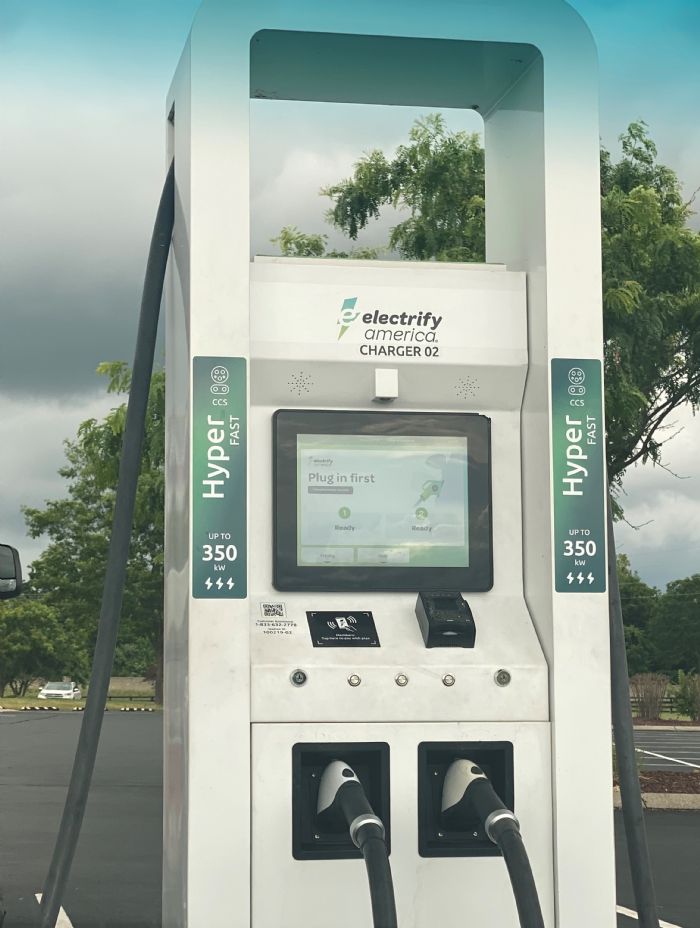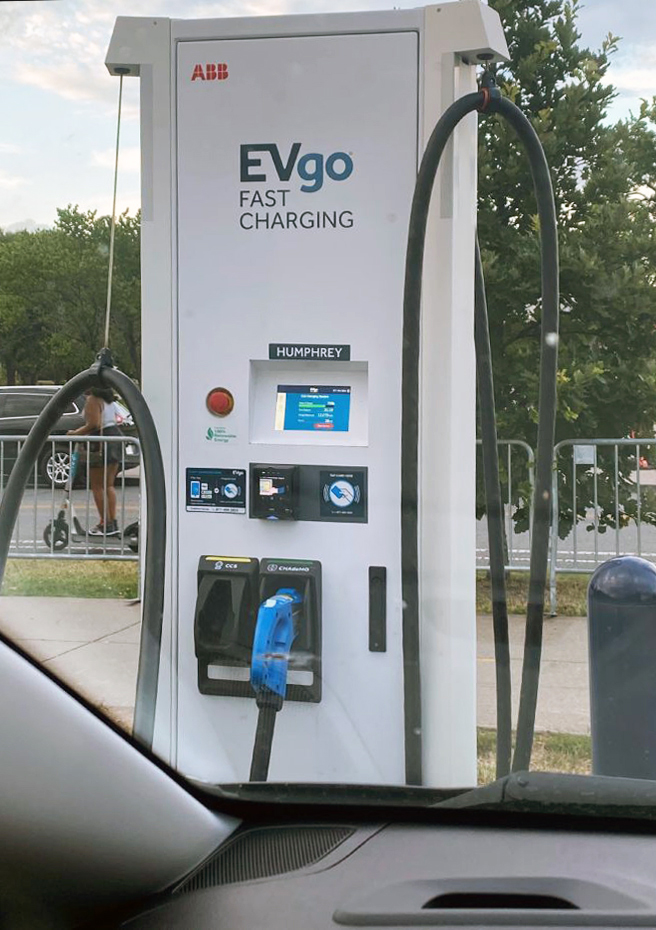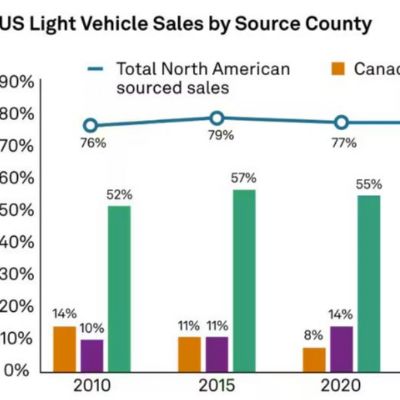 I thought I had to turn the car off while charging, like fueling gas. (I was wrong.)It was a very hot day, so we all got out of the car while it charged. One adult tried out a public scooter while we swwaited (sweated while waited). The others zoned into their smart phones.
I thought I had to turn the car off while charging, like fueling gas. (I was wrong.)It was a very hot day, so we all got out of the car while it charged. One adult tried out a public scooter while we swwaited (sweated while waited). The others zoned into their smart phones.
EVgo’s fast chargers can deliver power ranging from 50 to 350 kW, but the Bolt’s max charge rate of 50 kW reined in the speed. I charged for a little more than an hour to slightly above the 80% mark (charging slows after 80% capacity), to 228 mi., and my companions’ 100%-done-with-this point, disconnected and drove to the cabin.
There, beaming at having conquered “The Charging Station Experience,” I calculated how many miles I could charge overnight to add to what I had left. Figuring I’d have 212, I decided to confirm a tentative visit to a stamping company in Kentucky 195 mi. and 3 hr. away the next day. That’s where my reasoning took a wrong turn. I calculated that if I left by 10 a.m., I’d have an extra hour to spare before my 2 p.m. appointment. If needed, I could stop in Lexington at a fast-charging station enroute to top off.
Well, my departure was delayed to 10:30 a.m., so with only a half hour to spare, I pushed the speed limit a bit. I turned up the air conditioning and music. Before too long, I did a doubletake at the time. Apparently, Kentucky spans two time zones! Now, I was half an hour late.
I called my contact, advised that I would be late, depressed the accelerator a little harder, and kept a worried eye on my range. Soon, I had only 110 mi. range for the remaining 125-mi. trip. That’s when it dawned on me why the dashboard showed a max and min range above and below the “mileage remaining” number. Like a gas-fueled vehicle, the mileage varies depending on how fast you drive and how many auxiliary systems you use. Duh.
Concerned that I would not make it to Lexington without charging. I searched for a charging station—only level 2s lay between me and Lexington. I came to understand that a 6.5-kW charger meant that it was a level 2 AC, while DC fast chargers discharged 150 or 350 kW. I off-ramped to the charger’s location. There, at the back of a weedy parking lot facing Beards and Beers stood a 6.5 kW charging unit. I took some consolation in that even in a small town where you get your buzz and a buzz cut at the same place, you can charge your EV.
For this Chargepoint charger, I had to download an app to charge and pay. While charging and swwaiting for 45 min., I downloaded every EV app that I could: Electrify America, EVGo, InCharge, PlugShare … and watched as my mileage gauge slowly creeped up 18 mi. I searched my phone for a fast charger in Lexington, but nearly all were Supercharger stations, equipped with a NACS connector to which my Bolt could not connect.
At the intersection of not enough time and too many miles to go, I had to cancel the appointment.
The Oasis
Enroute to the Nashville airport, an Electrify America DC fast-charging station beaconed like a beam of light at, of all places, a National Corvette Museum in Bowling Green. There, multiple ports up to 350 kW lay open for the taking, and I joined other road-weary travelers to charge up, banking another 110 mi., and as grateful for the quicker recharge as a dusty cowboy at a saloon.
Since the Summer of 2023 …
Much has changed regarding battery range and charging-station availability since the summer of ’23. More than triple the 64,000 charging stations in place then are available now. Currently more than 210,000 public level 2 and 3 charging stations, equipped with multiple ports, dot the country at more than 76,000 locations, many funded by the Bipartisan Infrastructure Law, according to the U.S. Dept. of Energy. IONNA, a joint venture of eight major automakers, will add an additional 1000 charging bays by the end of this year. GM has discontinued Bolt production in favor of EVs equipped with its longer-range Ultium battery that features ranges of 300 to more than 400 mi. Many more EVs from multiple OEMs with 300-mi.-plus range are on the market. Virtually all automakers, including GM and Ford, have forged agreements with Tesla to use their Superchargers with an adaptor (later models won’t need an adaptor) that lets their CCS ports work with Tesla’s NACS ports. EVs equipped to charge at a rate of 400 kW on 1000-V DC fast chargers can charge as many as 200 mi. of range in 12 min.
The Price and The Cost
In terms of fees, charging at the cabin cost me nothing; the level 2 Chargepoint charger: $1.20 for 18 mi; the EVgo: $18.30 for 140 mi.; Electrify America: $13.76 for another 110 or so.
On the other hand, I’ve learned a bit about EV travel, including that I could have run the air while charging. I should have read “Electric Vehicle EV Road Trip Checklist Tips.” Dipping my toe into the water while on a fluid schedule was fine; scheduling a business trip 200 mi. away my first time out without solid planning; not a good idea. It cost me a meeting.
Now, a little EV-wiser, I’m thinking maybe it’s time to try again. Anybody up for a road trip? MF
Technologies: Management
 A caravan of gas-powered vehicles and my EV, we set out for Mammoth Caves. The quiet driving experience was pleasant, though the motor shutoff at stops was a little unnerving at first. After the cave excursion, we headed back. I tried not to gloat as the other family members had to stop at a gas station to fuel up while I just waited for them, and then casually, smugly plugged in at the cabin.
A caravan of gas-powered vehicles and my EV, we set out for Mammoth Caves. The quiet driving experience was pleasant, though the motor shutoff at stops was a little unnerving at first. After the cave excursion, we headed back. I tried not to gloat as the other family members had to stop at a gas station to fuel up while I just waited for them, and then casually, smugly plugged in at the cabin. 






 I thought I had to turn the car off while charging, like fueling gas. (I was wrong.)It was a very hot day, so we all got out of the car while it charged. One adult tried out a public scooter while we swwaited (sweated while waited). The others zoned into their smart phones.
I thought I had to turn the car off while charging, like fueling gas. (I was wrong.)It was a very hot day, so we all got out of the car while it charged. One adult tried out a public scooter while we swwaited (sweated while waited). The others zoned into their smart phones. 

